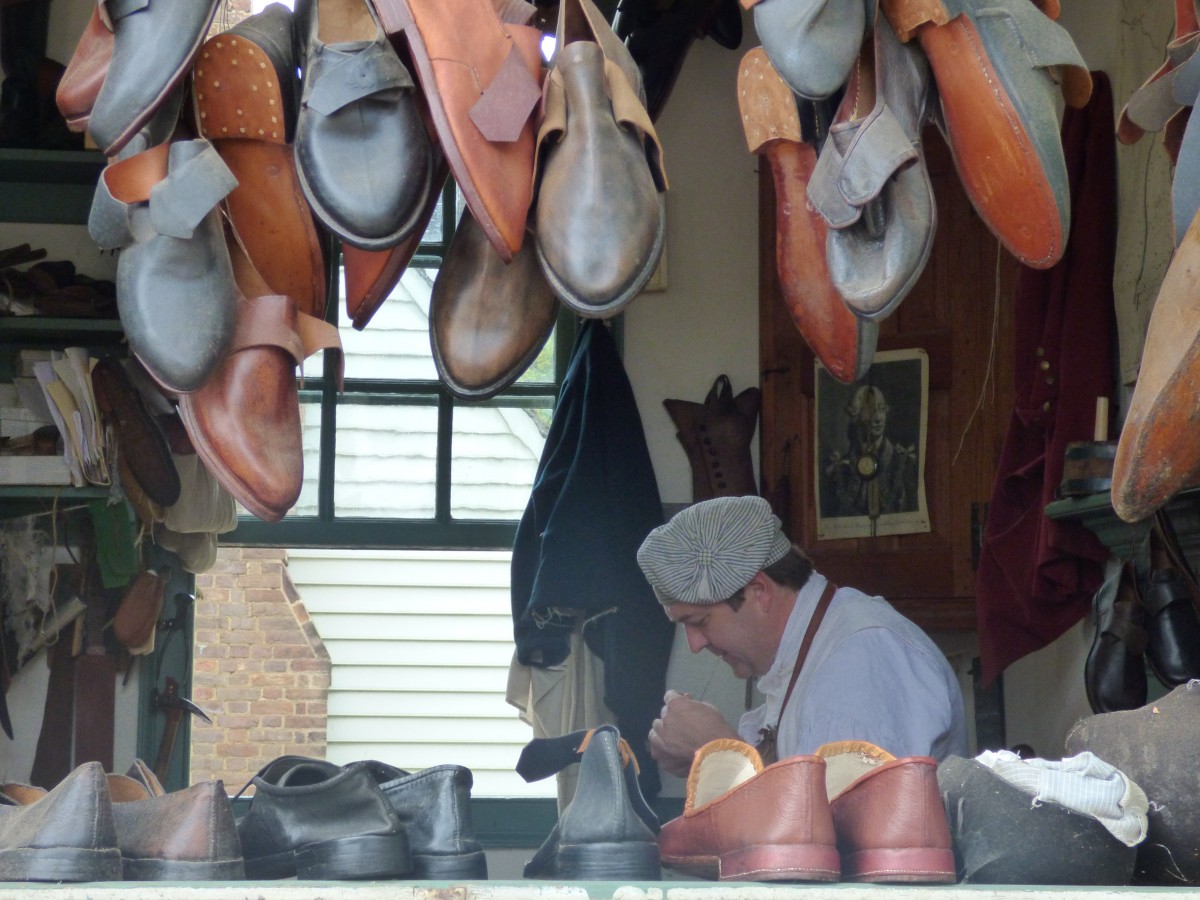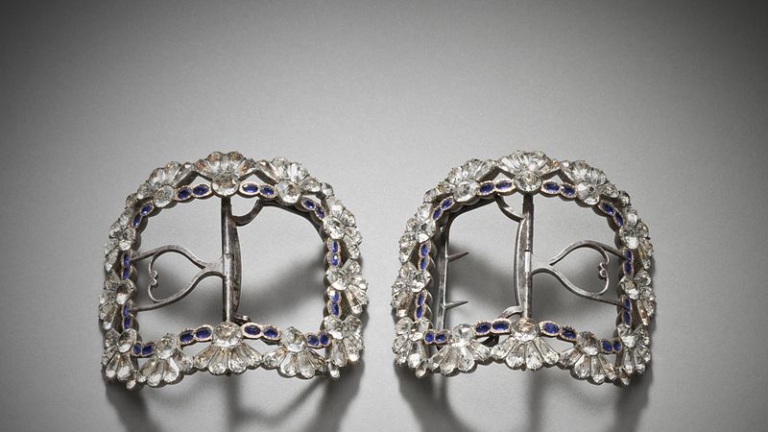Visiting the 18th Century

Accessories at Williamsburg
by Kendra Van Cleave, First published for the May/June 2011 issue of Finery
In March, Colonial Williamsburg presented a research symposium called “Costume Accessories: Head to Toe,” which coincided with an exhibition of (mostly 18th century) accessories at the DeWitt Wallace Decorative Arts Museum. When it was first announced, I thought, “Cool! But – why is everything good on the other side of the country?” However, a month later a friend talked me into attending! The draw: Colonial Williamsburg is the equivalent of 18th century Disneyland. The list of speakers included many famous costume researchers whose books and articles I had devoured for years. Finally, there would be a series of tours and workshops on 18th century costume that sounded fabulous. The trip of a lifetime!
Colonial Williamsburg is a combination of preserved and recreated buildings that make up the historic district of the city of Williamsburg, Virginia, which served as the capitol of Virginia from 1699 to 1780. A number of period buildings house historical interpreters demonstrating 18th century crafts, period themed restaurants, shops, and more.
Of course, I had to make new outfits for the trip! Luckily, I had started my 1760s Brunswick gown in the Burnley & Trowbridge workshop taught by Janea Whitacre (Williamsburg’s mantua maker and milliner) last summer. I finished up that outfit (although the skirt still needs trimming!), plus made a 1770s riding habit; unfortunately, plans to hand sew the habit flew out the window as work got busy and our trip approached! I also packed a robe à la française that is a perennial favorite for dressing up in the evenings.
The first day we spent in the DeWitt Museum enjoying the exhibition. Although the space was small, it worked quite well for an accessories exhibition. There were four full costumed mannequins, although the clothing was very much covered up with shawls, aprons, gloves, and many other accessories. Then, there was case after case of accessories: stomachers, gloves, kerchiefs, embroidery, shoes, pockets, aprons, stocks, hats, wigs, shoe buckles, jewelry, pocketbooks, muffs, mitts, and so much more! Most items were from the 18th century, but there were also a few 17th century and 19th century items. It was wonderful to get to peer up close at so many fiddly bits that normally I miss when I’m looking at costume exhibitions, because it’s so easy to get distracted by the big shiny dresses! Some of the most impressive items were various whites (sleeve ruffles, stocks, etc.) that had the tiniest hems and gathers you’ve ever seen! There were also some great pocketbook-type items that still had their original contents, like a tiny nail file, pencil, note cards, and more — all in miniature. Seeing so many items (for example, shoe buckles) in their original boxes was fabulous. The rest of the museum was quite interesting, with lots of portraits and various 18th century accoutrements. You can see an online presentation of the exhibition here: http://www.history.org/history/museums/clothingexhibit/index.cfm
The next two days were spent wandering Colonial Williamsburg in 18th century costume, going in and out of period trades shops, gift shops, and restaurants. There is a recreation of an 18th century milliner’s and tailor’s shop, where milliner/mantua maker Janea Whitacre and tailor Mark Hutter and their apprentices recreate period attire. It’s fascinating to watch them work and ask questions, plus you can handle most of the items as they are modern recreations! The wig shop has numerous recreations of period wigs, but even more interesting is watching the process of weaving hair wefts on small looms. I particularly enjoyed the weaver’s shop, as the interpreter that I spoke with there was full of fascinating information on weaving, fabrics, and women’s history in general.
There are multiple historic restaurants, although only the King’s Arms was open while we were there, so we ate there three different times (in costume, naturally!). The best event was probably the evening organized by Barbara Tyler-Mullins, who works at Colonial Williamsburg. She invited a huge group to have dinner in costume at the King’s Arms, followed by an 18th century chamber music concert in a period building across the street. It was absolutely magical to be surrounded by everyone in period costume, in period buildings, eating period-esque food, and listening to period music — all by candlelight!
Then, the symposium! I went on one of the optional pre-tours, which was a trip to see some 17th- and 18th-century costume items at the Jamestown-Yorktown Foundation’s collections facility. We got to get as close as close can be to men’s jackets, stays, gowns, calashes, and more!
The talks were fabulous! Some highlights: Linda Baumgarten (textiles & costume curator at Colonial Williamsburg) went into detail about many of the items in the exhibition. Phil Dunning (Parks Canada) spoke about a 1690 New England shipwreck, discussing the many costume-related items they found — and even bringing some of them along! Mark Hutter (Williamsburg’s tailor) gave a hilarious and hugely informative talk on the production and consumption of men’s accessories. Ann Bissonnette (asst. professor/clothing & textiles curator at the University of Alberta) talked about 18th century wigs, making connections with classical Roman styles. Cynthia Cooper (costume & textiles curator at the Musée McCord) discussed the development of the sash in the late 18th century, as well as trends for shawls and scarves in the early- and mid-19th century. Janea Whitacre spoke “Of All Things Millinerial,” while costumed models recreated scenes related to millinery production and consumption. More on these talks and others is available on the “Two Nerdy History Girls” blog.
The final day included a number of costume-related workshops. I attended “Celebrating the Mysteries of 18th-century Hair and Beauty Secrets.” Taught by Williamsburg’s wigmaker Betty Williams, we learned both period and modern techniques for recreating 18th century wigs, including weaving hair wefts. They brought a number of recreated wigs, and showed us many of their techniques. I got some great tips!
Of course, by the end of the trip, I was exhausted, but I returned home with lots of fabulous information and having met a number of different costume researchers and bloggers. You can see my photos from the exhibition and trip on Flickr: http://www.flickr.com/photos/demode/sets/72157626202013775/





Leave a comment